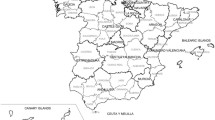Abstract
Analytical disease mapping aims at linking control variables, the exposure to potential risk factors and to protective elements with the geographical distribution of disease events. Its goals are (a) to identify areas of atypical low and high disease risk and (b) to enhance our understanding of the underlying disease generating process. However, along with many other obstacles in analytical disease mapping, interregional migration masks for degenerative diseases with a long latency period any direct regional association between the observed disease rates and risks factors. Prostate gland cancer mortality rates of the 508 State Economic Areas (SEA) for the reporting period 1970–1994 are linked in an ecological regression model to proxy variables of putatively influential factors. A semi-parametric geographical filtering approach that uses the 1965–1970 interregional census migration flows among the SEA as underlying spatial structure is applied to control for confounding migration effects. This approach allows, despite some simplifying assumptions, to assess direct effects of potential risk factors on the spatial variability of prostate cancer and to visualize underlying spatial dimensions of the disease generating process. Results indicate a shift in relevance of the incorporated exogenous variables.









Similar content being viewed by others
References
Arnold RA, Diamond ID, Wakefield JC (2000) The use of population data in spatial epidemiology. In: Elliott P, Wakefield JC, Best NG, Briggs DJ (eds) Spatial epidemiology. Methods and applications. Oxford University Press, New York
Bentham G (1988) Migration and morbidity: implications for geographical studies of disease. Soc Sci Med 26:49–54
Best NG (1999) Bayesian ecological modelling. In: Lawson, Andrew B, Annibale B, Dankmar B, Lesaffre E, Viel J-F, Bertollini R (eds) Disease mapping and risk assessment for public health. Wiley, New York
Box GEP, Cox DR (1964) An analysis of transformations. J Roy Stat Soc.Series B Methodol 26:211–252
Bureau of Census (1975) Migration Between State Economic Areas. 1970 Census of Population. Vol Subject Report PC(2)-2E Atlanta, US Department of Commerce
Cliff Andrew D, Keith Ord J (1981) Spatial processes. Models & applications. Pion Limited, London
Cohen, Bernard L (2004) Test of the linear-no threshold theory of radiation carcinogenesis for inhaled radon decay products. Health Phys 68:157–174
Devesa, Susan S, Dan J Grauman, William J Blot, Gene A Pennello, Robert Hoover, Joseph F Fraumeni (1999) Atlas of Cancer Mortality in the United States, 1950–94. NIH Publication No. 99–4564 ed. National Cancer Institute, Bethesda
Gatrell AC (1983) Distance and space. A geographical perspective. Clarendon Press, Oxford
Gatrell AC (2002) Geographies of health. An introduction. Blackwell, Malden
Gelman A, Stephen A, Price PN, Park DK, Minnite LC (2001) Models, assumptions, and model checking in ecological regression. J Roy Stat Soc Ser A General 164:101–118
Gelman A, Price NP (2006) Radon project. Available from http://www.stat.columbia.edu/radon/ Last accessed July 1, 2006
Gelman Andrew, Phillip N Price (1999) All maps of parameter estimates are misleading. Stat Med 18:3221–3234
Griffith DA (2003) Spatial autocorrelation and spatial filtering. Gaining understanding through theory and scientific visualization. Springer, Berlin
Haining R (1990) Spatial data analysis in the social and environmental sciences. Cambridge University Press, Cambridge
Kjellberg S, Wiseman JS (1995) The relationship of radon to gastrointestinal malignancies. Am Surg 61:822–825
Kliewer EV (1992) Influence of migrants on regional variations of stomach and colon cancer in the Western United States. Int J Epidemiol 21:442–449
Knorr-Held L, Best NG (2001) A shared component model for detecting joint and selective clustering of two diseases. J Roy Stat Soc Ser A General 164:73–85
Löytönen M (1998) GIS, time geography and health. In: Anthony GC, Löytönen M (eds) GIS and health. Taylor & Francis Ltd, London
Marshall RJ (1991) A review of methods for the statistical analysis of spatial patterns of disease. J Roy Stat Soc Ser A General 154:421–441
Morgenstern H (1998) Ecologic studies. In: Rothman KJ, Sander G (eds) Modern epidemiology, 2nd edn. Lippincott Williams & Wilkins, Philadelphia
National Cancer Institute (2006) Cancer mortality, graphs & trends. Available form http://www3.cancer.gov/atlasplus/. Last accessed July 1, 2006
National Research Council (1999) Risk Assessment of radon in drinking water. National Academy Press, Washington
Pickle LW, Su Y (2002) WithinpState geographic patterns of health insurance coverage and health risk factors in the United States. Am J Prevent Med 22:75–83
Pocock SJ, Derek GC, Shirley AAB (1981) Regression of area mortality rates on explanatory variables: what weighting is appropriate. Appl Stat 30:286–295
Polissar L (1980) The effect of migration on comparison of disease rates in geographic studies in the United States. Am J Epidemiol 111:175–82
Richardson S (1992) Statistical methods for geographical correlation studies. In: Elliott P et al (eds) Geographical and environmental epidemiology: methods for small-areas studies. Oxford Medical Publication, Oxford
Rogerson P, Daikwon H (2002) The effects of migration on the detection of geographic differences in disease risk. Soc Sci Med 55:1817–1828
Rothman KJ (1990) Keynote presentation. A sobering start for the cluster buster’s conference. Am J Epidemiol 132:S6–S13
Tiefelsdorf M (1998) Some practical applications of Moran’s I’s exact conditional distribution. Papers Reg Sci 77:101–129
Tiefelsdorf M (2000) Modelling spatial processes—the identification and analysis of spatial relationships in regression residuals by means of Moran’s I. Springer, Berlin
Tiefelsdorf M (2003) Misspecifications in Interaction model distance decay relations: a spatial structure effect. J Geogr Syst 5:25–50
Tiefelsdorf M, Griffith DA (2007) Semiparametric filtering of spatial autocorrelation: the eigenvector approach. Environ Plann A 39:1193–1221
Wakefield JC (2004) Ecological inference for 2 × 2 tables. J Roy Stat Soc Ser A General 167:385–445
Waller LA, Gotway C (2004) Applied spatial statistics for public health data. Wiley, Hoboken
Acknowledgments
The author gratefully acknowledges the support by the National Institutes of Health (research grant # 1 R1 CA95982–01).
Author information
Authors and Affiliations
Corresponding author
Rights and permissions
About this article
Cite this article
Tiefelsdorf, M. Controlling for migration effects in ecological disease mapping of prostate cancer. Stoch Environ Res Risk Assess 21, 615–624 (2007). https://doi.org/10.1007/s00477-007-0148-8
Published:
Issue Date:
DOI: https://doi.org/10.1007/s00477-007-0148-8




